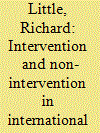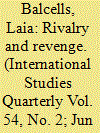| Srl | Item |
| 1 |
ID:
124133


|
|
|
|
|
| Publication |
2013.
|
| Summary/Abstract |
This article aims to show that from the end of the eighteenth century, international order began to be defined in terms of ground rules relating to non-intervention and intervention, with the former being prioritised over the latter. After the Napoleonic wars, within continental Europe there was an attempt to consolidate an intervention ground rule in favour of dynastic legitimacy over the right of self-determination. By contrast, the British and Americans sought to ensure that this ground rule was not extended to the Americas where the ground rule of non-intervention was prioritised. During the nineteenth century, it was the Anglo-American position which came to prevail. Over the same period international order was increasingly bifurcated with the non-intervention ground rule prevailing in the metropolitan core and with the intervention ground rules prevailing in the periphery. This article, however, only focuses on the metropolitan core and draws on two case studies to examine the non-intervention ground rule in very different circumstances. The first examines the British response to the American Civil War in the 1860s during an era of stability in the international order. The second explores the British Response to the Spanish Civil War in the 1930s when the international order was very unstable and giving way to a very different international order.
|
|
|
|
|
|
|
|
|
|
|
|
|
|
|
|
| 2 |
ID:
096686


|
|
|
|
|
| Publication |
2010.
|
| Summary/Abstract |
Recent research on violence against civilians during wars has emphasized war-related factors (such as territorial control or the characteristics of armed groups) over political ones (such as ideological polarization or prewar political competition). Having distinguished between irregular and conventional civil wars and between direct and indirect violence, I theorize on the determinants of direct violence in conventional civil wars. I introduce a new data set of all 1,062 municipalities of Catalonia during the Spanish Civil War (1936-1939) and I show that the degree of direct violence against civilians at the municipal level goes up where prewar electoral competition between rival political factions approaches parity. I also show that, following the first round of violence, war-related factors gain explanatory relevance. In particular, there is a clear endogenous trend whereby subsequent levels of violence are highly correlated with initial levels of violence. In short, the paper demonstrates that an understanding of the determinants of violence requires a theory combining the effect of political cleavages and wartime dynamics.
|
|
|
|
|
|
|
|
|
|
|
|
|
|
|
|
| 3 |
ID:
093917


|
|
|
|
|
| Publication |
2010.
|
| Summary/Abstract |
Insurgencies that recruit foreign nationals to join rebel groups in various civil wars around the globe are a source of growing concern to policymakers. Despite attention focused on recent Islamist groups, foreign fighters are a phenomenon that is neither new nor uniquely Islamic. In conflicts from the Spanish Civil War to the Afghanistan War, insurgencies consistently recruited foreigners by framing the local war as one that threatened a shared transnational identity group and necessitated a defensive mobilization. It is therefore possible to draw lessons about combating their flow through counter-recruitment from a wide array of historical cases.
|
|
|
|
|
|
|
|
|
|
|
|
|
|
|
|